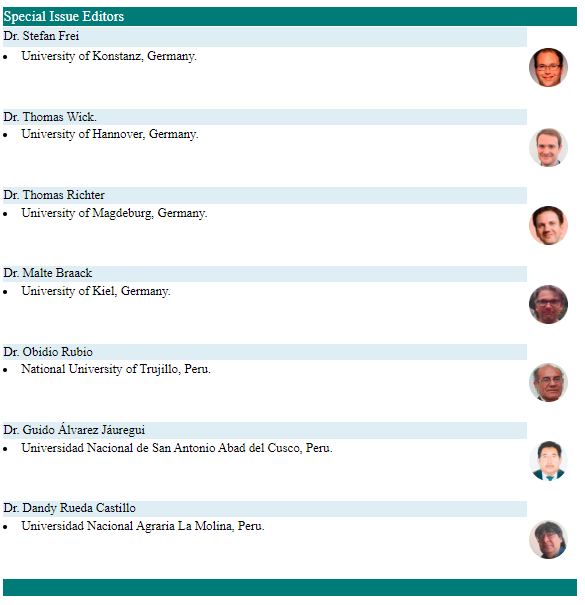Value of the golden ratio (number Phi) knowing the side length of a square
DOI:
https://doi.org/10.17268/sel.mat.2021.02.16Palabras clave:
Number phi, Golden ratio, FibonacciResumen
This paper explains how to obtain the number phi using a square with side length equal to a, the right triangle with sides a=2 and a, and a circle with radius equal to the hypotenuse of this right triangle. In particular, from a square whose side length is equal to a, we will show how to obtain a segment b in such a way that the value of a=b is the number phi. It is well known that this ratio is also calculated from equating the ratios obtained by dividing a segment of length a + b by a (being a always the largest segment) and a by b, that is, (a + b)=a = a=b. This equality is a consequence of the ratio of proportionality in triangles applying Thales’s Theorem. And, we must mention also how this golden ratio it is obtained as a consequence of the Fibonacci sequence. However, the golden ratio as a consequence of the limit of Fibonacci sequence was found later than many masterpieces, as for instance the ones of Leonardo da Vinci. This is the main reason because we analyzed how to find the proportionality golden ratio using the most common geometric figures and its symmetries. This paper aims to show how the golden ratio can be obtained knowing the side length a of a square.
Citas
Weisstein EW. Golden Ratio Conjugate. CRC Concise Encyclopedia of Mathematics. Second Edition. USA: CRC Press; 2002.
Livio M. The golden Ratio: The Story of Phi, The World’s Most Astonishing Number. New York City: Broadway Books; 2003.
Dunlap RA. The Golden Ratio and Fibonacci Numbers. New Jersey: World Scientific Publishing, 1997.
Euclid, Charles S, Willock-Bryant S. Euclid’s Elements Of Geometry: Books I-IV, VI and XI. New York: Palala Press; 2016.
Fink K, Beman WW, Smith DE. A Brief History of Mathematics: An Authorized Translation of Dr. Karl Fink’s Geschichte der Elementar-Mathematik. 2nd Edition. Chicago: Open Court Publishing Co; 1903.
Lidwell W, Holden K, Butler J. Universal Principles of Design: A Cross-Disciplinary Reference. Rockport Publishers; 2003.
Hemenway P. Divine Proportion: Phi In Art, Nature, and Science. New York: Sterling; 2005.
Baravalle HV. The geometry of the pentagon and the golden section. Mathematics Teacher. 1948; Vol 41: 22-31.
Schreiber P. A Supplement to J. Shallit’s Paper ”Origins of the Analysis of the Euclidean Algorithm”. Historia Mathematica. 1955; 22(4):422–424.
Herz-Fischler R. A Mathematical History of Division in Extreme and Mean Ratio. Waterloo: Wilfrid Laurier University Press; 1987.
Posamentier AS, Lehmann I. The Glorious Golden Ratio, New York: Prometheus Books; 2011.
Barr M. Parameters of beauty. Architecture (NY). 1929; Vol 60:325.
Dowling TA, Shier DR. Handbook of discrete and combinatorial mathematics. Boca Raton: CRC Press; 1999.
Trebst S, Troyer M, Wang Z, Ludwig AWW, A Short Introduction to Fibonacci Anyon Models. Progress of Theoretical Physics Supplement. 2008; Vol 176:384-407.
Descargas
Publicado
Cómo citar
Número
Sección
Licencia
Derechos de autor 2021 Selecciones Matemáticas

Esta obra está bajo una licencia internacional Creative Commons Atribución 4.0.
Los autores/as que publiquen en esta revista aceptan las siguientes condiciones:
- Los autores/as conservan los derechos de autor y ceden a la revista el derecho de la primera publicación, con el trabajo registrado con la licencia de atribución de Creative CommonsAtribución 4.0 Internacional (CC BY 4.0) , que permite a terceros utilizar lo publicado siempre que mencionen la autoría del trabajo y a la primera publicación en esta revista.
- Los autores/as pueden realizar otros acuerdos contractuales independientes y adicionales para la distribución no exclusiva de la versión del artículo publicado en esta revista (p. ej., incluirlo en un repositorio institucional o publicarlo en un libro) siempre que indiquen claramente que el trabajo se publicó por primera vez en esta revista.
- Se permite y recomienda a los autores/as a publicar su trabajo en Internet (por ejemplo en páginas institucionales o personales) antes y durante el proceso de revisión y publicación, ya que puede conducir a intercambios productivos y a una mayor y más rápida difusión del trabajo publicado(Consultar: efecto del acceso abierto).













